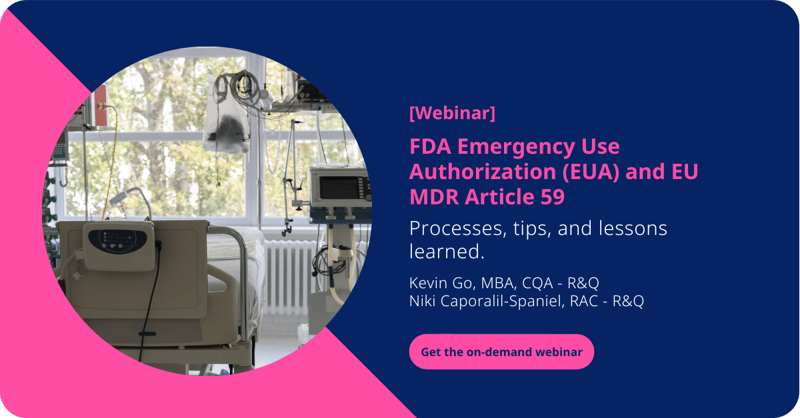26 May 2020 - Processes, tips, and lessons learned.
► Special note: On April 24th we recorded an episode of DEVICE L❤️VE Live! on this topic. While the intent of our webinars is to strategically dive deep into a topic, our weekly live shows are more of a discussion. View the episode on demand for a taste of what the webinar will offer!
--
FDA Emergency Use Authorization (EUA) process and EU MDR Article 59 to release devices needed for prevention and treatment of COVID-19
In response to the COVID-19 global pandemic, health authorities are taking the necessary steps to allow for greater access to and use of critical medical devices and PPE that are in short supply. However, some manufacturers lack the necessary regulatory approvals needed to make their medical devices/PPE available. In situations such as these, both the United States (FDA) and European Union (European Commission) have legislation in place to help bring these critical products to patients and healthcare workers for emergency applications.
In the United States, the US FDA has invoked the Emergency Use Authorization (EUA) authorizing the use of an unapproved product or an unapproved use of an approved product, provided that other statutory criteria are met.
In the European Union, Article 59 of the EU MDR (2017/745) can be used where the European Commission is responsible for identifying and authorizing certain medical devices and PPE that may be sold without CE Marking during the public health emergency and market access is granted individually by the Competent Authority of each member state. The EU has issued an implementing act restricting export of PPE from the EU and recommended conformity assessment procedures within the context of the COVID-19 threat.
In this webinar, we’ll discuss both emergency application processes, provide answers to the many questions we've received, and share tips and lessons learned from our experiences.
Agenda:
— FDA EUA Process
- Detailed process
- How is it different from the 510(k) process? Discuss Medical Devices and IVD’s.
- What are the basic requirements for the manufacturer, for example QMS, FDA registration, supplier controls, and post market surveillance to name a few? And what if a device fails?
- What happens after the crisis? Is a 510(k) needed to continue commercialization?
— EU MDR Article 59
- Detailed process
- How is it different from traditional CE marking?
- What are the basic requirements for the manufacturer? Will the manufacturer be audited?
- What happens after the crisis? Is the CE marking still valid?
— Tips and lessons learned




